Curiosities
What’s With All the Hitler NFTs? Will Robots Put Street Artists Out of Work? + Other Questions I Have About The Week’s Art News
Thoughts on some dumb NFTs, IP dilemmas in the art world and out, and a weird way to sell cashmere sweaters.
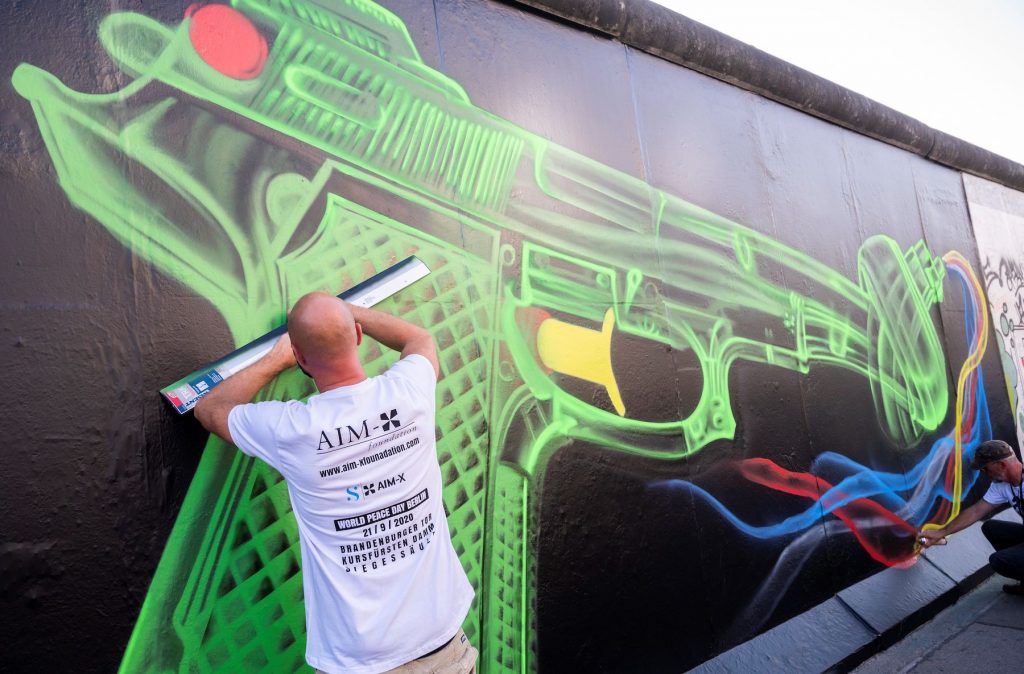
Thoughts on some dumb NFTs, IP dilemmas in the art world and out, and a weird way to sell cashmere sweaters.

Ben Davis

Curiosities is a column where I comment on the art news of the week, sometimes about stories that were too small or strange to make the cut, sometimes just giving my thoughts on the highs and lows.
Below, some questions posed by the events of the last week…
Sometime in the middle of last week I started getting texts from people sounding the alarm about all the Hilter NFTs.
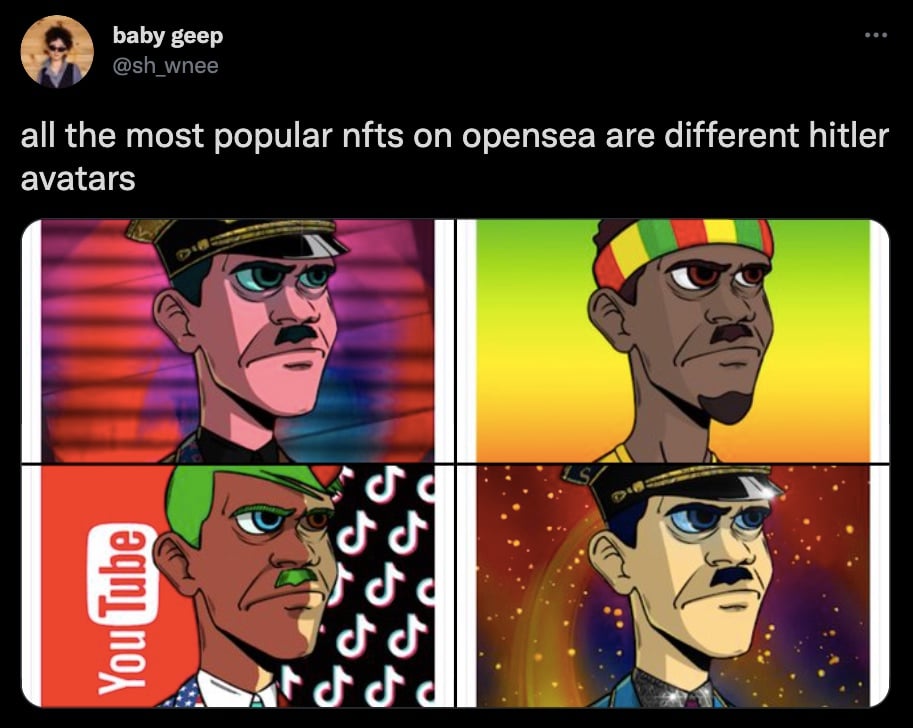
Screenshot of the Tweet that sounded the alarm on the HITL NFT.
By the time of this writing, stories in Vice and others have forced action: the star offender in the Hitler NFT space, HITL NFT, has vanished from OpenSea, the big NFT trading site. It featured an assortment of collectible cartoon Hitlers styled in different jokey attires (with a pink fedora, with a half-robot face like the Terminator, with a Louis Vuitton-branded military visor).
Not even enough evidence remains of the original HITL NFT on the web for me to reconstruct the offerings, and the “WTF—Hitler??” tone of the hot takes doesn’t really help me figure it out. Based on what I do know, it seems less a new nexus for the alt-right and more an exercise in irony-poisoned, attention-seeking dude humor—a very large category of content on OpenSea, which is basically the Cedar Bar of irony-poisoned attention-seeking dudes.
If you are desperate to still spy a green-mustached HITL NFT in the wild, though, don’t worry! Demonstrating the game of digital Whac-a-Mole that is online content moderation, HITL NFT’s wacky Hitler avatars still appear on OpenSea in the form of “Marble Cards,” a low-grade line of NFTs that indiscriminately transforms webpages into tradable images on a marbled, trading-card background. A number of the HITL NFTs have been “marbled” and are still available for purchase.
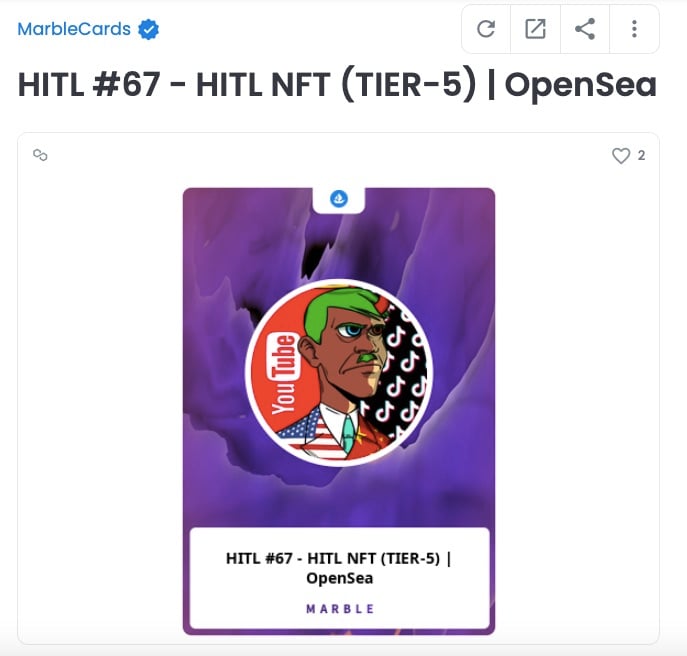
Screenshot of one of the HITL NFT Marble Cards on OpenSea.
(As a side note for art lovers forced to wade through yet another story about NFTs, the voracious “Marble Cards” algorithm has also hoovered up most of WikiArt, so that you can own unauthorized “cards” of Marina Abramović, Jasper Johns, Jeff Koons, Yayoi Kusama, Bruce Nauman, Cindy Sherman, Gerhard Richter, and many other living artists.)
You can also find the entire batch of HITL NFTs preserved on something called the OddandHairy Collection. As far as I can tell, this is the initiative of an inept NFT enthusiast hoping to fool an even more inept NFT enthusiast by selling images ripped off in bulk from a random assortment of NFT collections, from the renowned CryptoPunks to the much-less-renowned Crypto Titties.
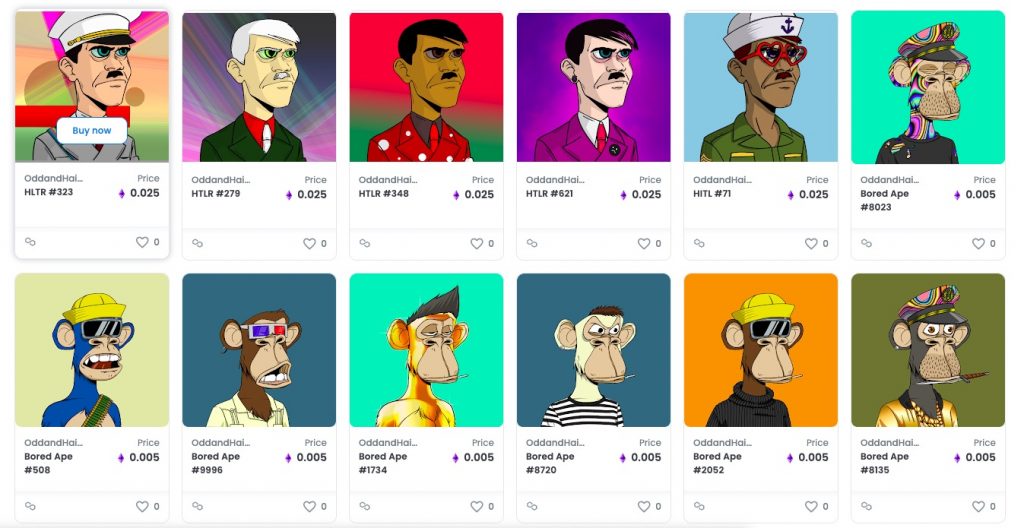
Screenshot of the OddandHairy Collection page on OpenSea, featuring copies of HITL NFT and Bored Ape Yacht Club NFTs.
In any case, does OpenSea have a “Hitler problem?”
I mean, yes, in the sense that there are a lot of things named “Hitler” on the site, as well as tokenized black-and-white historical photos of the genocidal dictator.
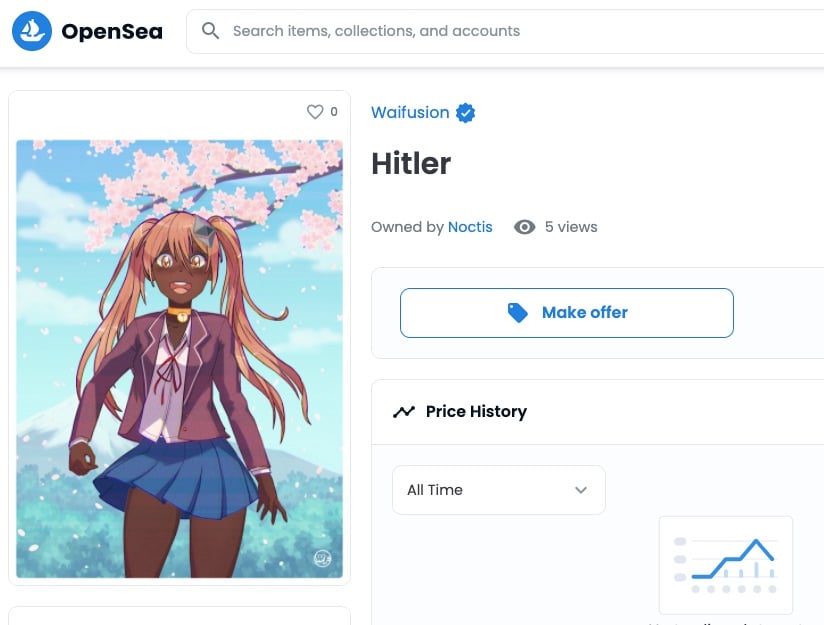
Screenshot of “Hitler” NFT from the Waifusion collection on OpenSea.
The tweet that detonated the Hitler NFT furor stated “all the most popular nfts on opensea are different hitler avatars.” It featured screen caps of four HITL NFTs, each favorited more than 20,000 times—which is indeed a lot, though actually not enough to be “the most popular,” at least not right now.
Who knows how that happened. Unfortunately, since the collection is now offline and no one actually did any real reporting besides recirculating that one tweet, you can’t see who the likes were actually from.
But the thing you should know is that there is no real market for Hitler NFTs!
According to NFT Stats, a data tracker, daily trading volume in HITL NFT peaked at a whopping $736 on October 4. That’s $736 more than anyone should pay, but as a sign of the times, it’s not exactly the fall of Paris.
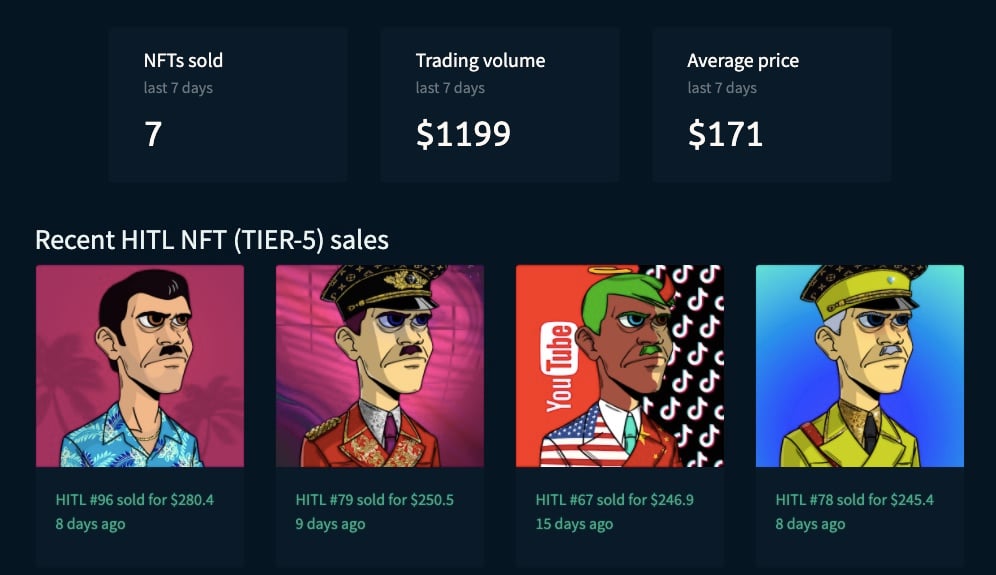
Screenshot from NFT Stats tracking sales of the HITL NFT, taken on October 11, 2021.
Between September 13 and October 7, when HITL NFT vanished into the ether, the collection sold anywhere between 3 and 0 NFTs a day.
Look, OpenSea has a definite nasty content problem. It takes about two seconds to find rape-themed or conspiracy-themed content for sale, alongside all the Hitler LOLZ. But for the most part, from what I can tell, none of the most openly monstrous stuff is burning up the charts.
Say what you will about NFT traders, but they are mainly in it to flip to a higher bidder, and it turns out that “Hitler” is actually not a brand name that people associate with “winning investment.” That’s actually comforting!
Over in Berlin, artist and technologist Niklas Roy has mildly intrigued the graffiti world with his Graffomat, a DIY setup that automates the process of tagging, promising “interesting and inspiring aesthetic outcomes.” Now, instead of working that spray can yourself, you can just put your design into a computer, then stand back and watch a machine do the work while you vape and watch YouTube videos on your phone.
Roy’s Graffomat joins a distinguished list of attempts to cut robots in on the street art heat. Most recently, you have Estonian inventor Mihkel Joala’s SprayPrinter, a wall-crawling robot Giotto.
That initiative has even spun off into the start-up Robot Muralist. On the one hand, the company boasts that the SprayPrinter “will disrupt the manually intensive way that murals are created.” On the other, Joala’s co-founder Richard Murutar promises the technology will “help humanity to the next level of consciousness through uplifting Art.”
That’s how it begins, with the robots “helping.” But get Artificial Intelligence in the mix, and pretty soon the Machines will take over, performing feats of imagination that we thought only human street artists could ever come up with—like painting a giant Frida Kahlo face wearing a KN95 mask, or a mural of Jeff Bezos and Elon Musk playing soccer, only the ball is THE EARTH…
Sure, the art world is bad. It’s goofy and status-obsessed. Plus, money is everywhere but no one is ever paid enough, etc., etc. But have you considered—the literary world?
I won’t recap this week’s viral literary-gossip blockbuster from the Times, “Who Is the Bad Art Friend?”, because it’s been the talk of after-work Zoom happy hours all week. Suffice to say that it involves a war in the creative writing community between Dawn Dorland, an aspiring writer and extremely enthusiastic kidney donor, and Sonya Larson, a more successful writer who appropriated Dorland’s public letter to her kidney donee whole into a short story, “The Kindest,” rendering it as a metaphor for privilege.
My colleague Sarah Cascone already went over the fun detail that the question of which writer is legally (if not ethically) in the right hinges on the unexpected precedent of Andy Warhol’s use of a photo of Prince. Doesn’t that feel like we are playing a kind of word-association game that involves getting as far away from the original people as possible while still staying plausibly relevant?
I guess my main thought was that the literary world’s big-little scandal of the week actually serves as a nice counterpoint to the art world’s big-little scandal of the week: Jasper Johns settling a dispute with a Cameroonian teenager, Jéan-Marc Togodgue, over his appropriation of his drawing of a knee.
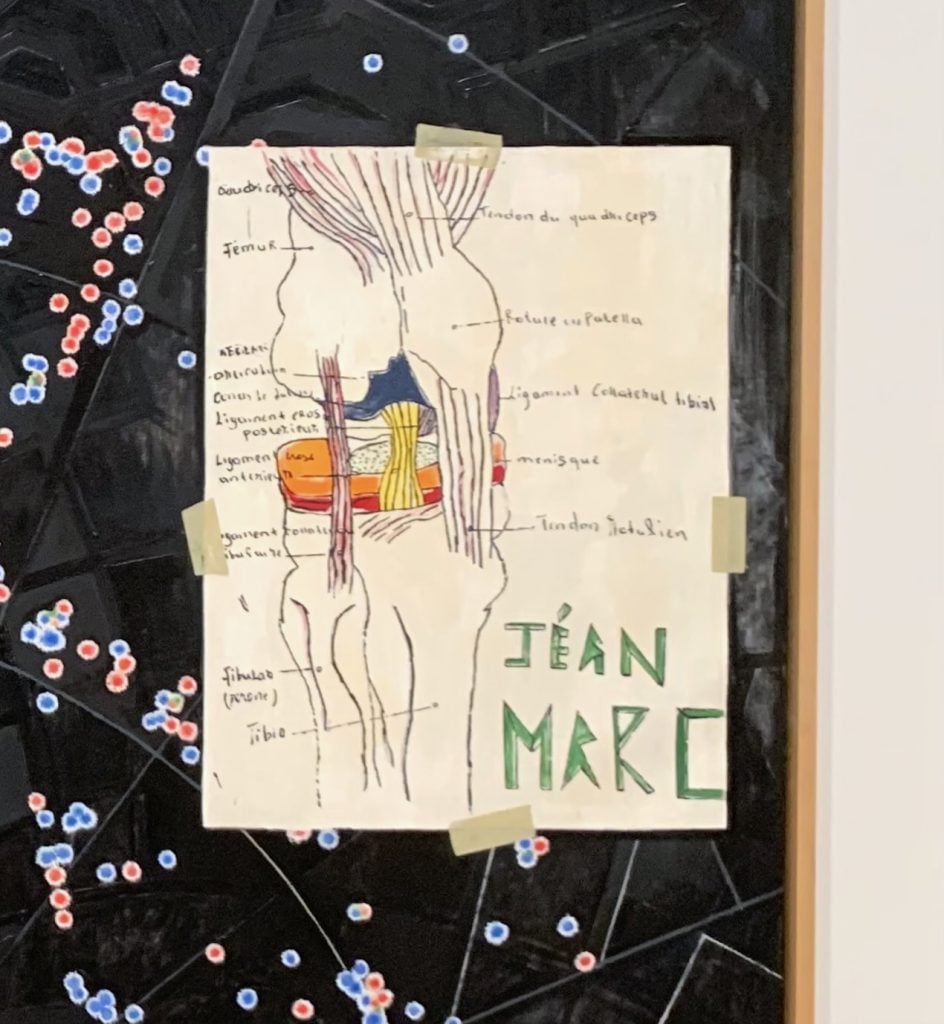
Detail of Jasper Johns, Slice (2020), featured in “Jasper Johns: Mind/Mirror” at the Whitney. Photo by Ben Davis.
The nonagenarian artist apparently saw the drawing in the office of the doctor they share, liked it, and worked a copy into a painting (Slice, 2020) before it occurred to him to approach the teen about crediting him. Johns got called out for exploitation, but they worked it out for a sum that is undisclosed but agreeable enough that Togodgue and his host family ended up grinning in front of Johns’s painting at the Whitney.
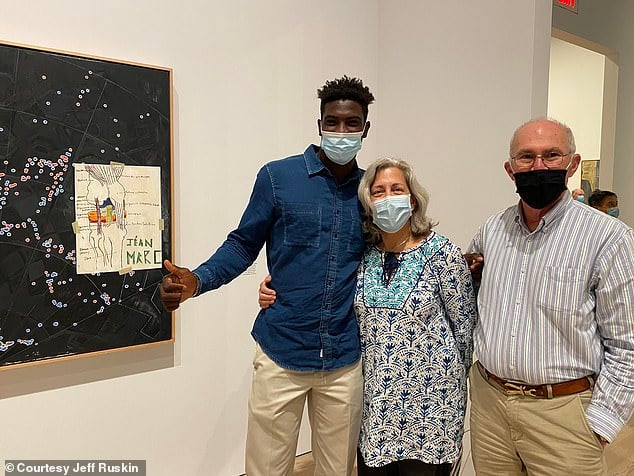
Jéan-Marc Togodgue and his host parents, Rita Delgado and Jeff Ruskin, with Jasper Johns’s Slice at the Whitney Museum of American Art in New York. Photo courtesy of Jeff Ruskin.
Meanwhile, literally everyone over in the “Art Friend” zone ends up seeming like allegorical characters in a tale meant to illustrate “reasons to avoid creative writing programs.” This probably has less to do with the innate temperaments of writers versus artists, though, and more to do with a variation on Sayre’s Law: “In any dispute the intensity of feeling is inversely proportional to the value of the issues at stake.”
God knows how much Jasper Johns’s handlers have to splash around. Meanwhile, the line that haunts the mind from the Times’s “Bad Art Friend” story is from Larson’s lawyer, defending the writer from demands for damages over her appropriation: “My client’s gross receipts from ‘The Kindest’ amounted to $425.”
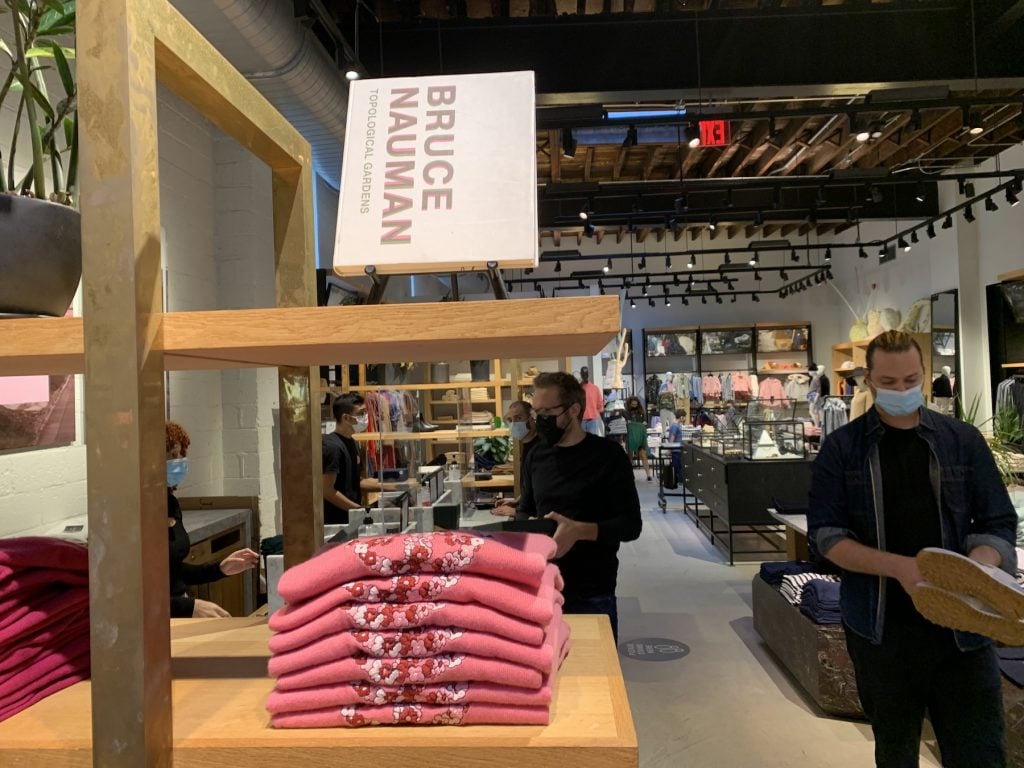
Bruce Nauman catalogue on display at the Williamsburg, Brooklyn, J. Crew store. Photo by Ben Davis.
A very small thing to take us out: Gotta love this J. Crew’s bold use of Bruce Nauman catalogues to accent the in-store sweater display.
I know that scattering art catalogues about is the way that hotel lobbies, model homes, and retail spaces everywhere signal, “Hey, affluent people—we get you! We too buy books to look smart that we don’t read.”
But I like to think it’s more deliberate in this case. I like to imagine that some retail genius out there thought to themselves, “You know what? Bruce Nauman’s signature brand of bodily discomfort and existential dread—that’s exactly what we need to get people into the ‘cashmere classic-fit crewneck sweater with floral peace embroidery.’”